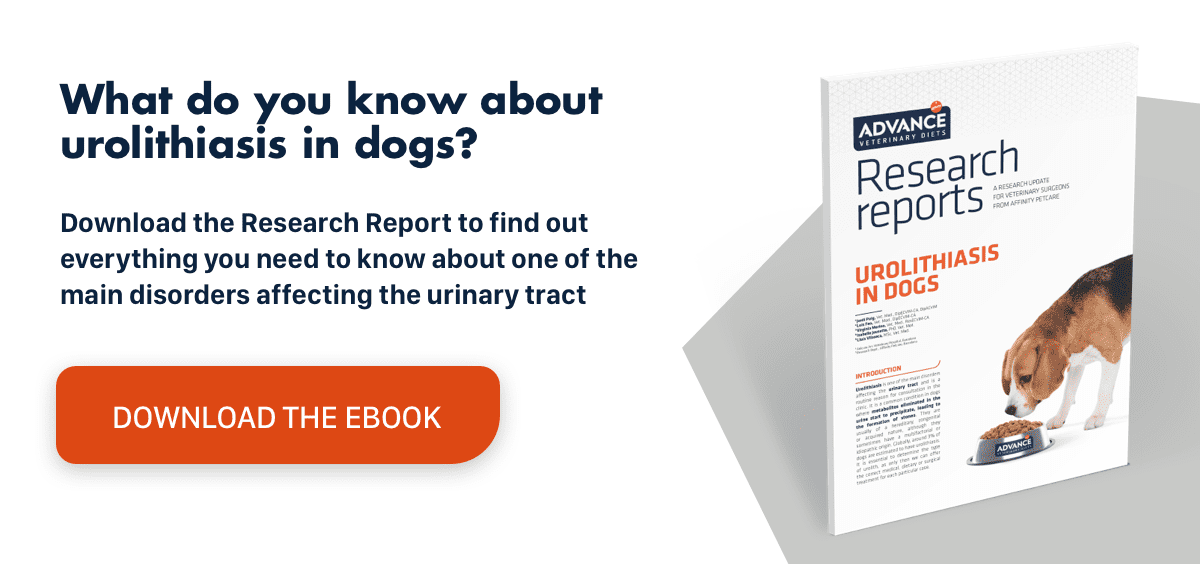High blood urea in dogs: diagnostic significance and clinical interest
When tests return a high blood urea in dogs, it is not necessarily indicative of kidney disease and other possible causes should be investigated.
Introduction
Blood urea is one of the most tested analytical parameters in routine clinical practice, not just because it is a marker of renal failure, but also because it forms part of routine blood chemistry profiles.
As such, vets must be familiar with the various processes that lead to high blood urea (uraemia) in dogs and how to act in such situations.
Physiological memory
Urea is synthesised in the liver from ammonium produced by the catabolism of amino acids that are obtained from both exogenous (dietary) and endogenous protein sources.It is excreted almost exclusively through the kidneys; even though relatively large amounts of urea are broken down into ammonia by gut bacteria, this ammonia is subsequently recycled back into urea in the liver. In the kidneys, urea is filtered freely in the glomerulus and reabsorbed in the tubules. The degree of urea reabsorption depends on urine flow.1
On this basis, urea has been (and is still) used as an indirect marker of glomerular filtration rate (GFR), forming part of the diagnostic panel for patients with suspected kidney disease.2 However, urea is an insensitive (urea plasma concentration only increases in the latter stages of kidney disease) and nonspecific marker (uraemia can be caused by various extrarenal factors) of renal dysfunction. Consequently, blood urea should always be assessed with other markers of renal function (creatinine, SDMA, proteinuria, urinary specific gravity, etc.). 2,3
High blood urea in dogs: causes
Although it is sometimes assumed that an increase in blood urea is due to a decline in the GFR caused by a pre-existing renal disease, it should be noted that there are several situations in which dogs may have high blood urea but without suffering renal dysfunction.
Causes of high blood urea in dogs:
- Reduction in GFR (prerenal/renal/postrenal)
- High protein diets
- Gastrointestinal bleeding
- Medications (tetracyclines, corticosteroids, azathioprine)
- Increased protein catabolism
However, the relationship between blood urea and GFR is not linear. This means that:
- In the early stages of disease, very large reductions in GFR are associated with very slight or even imperceptible increases in urea concentration;
- However, in cases of very advanced disease, small reductions in an already very low GFR are accompanied by significant increases in blood urea levels. 1,2
As tubular reabsorption of urea increases substantially when urine output decreases, hypovolaemic or dehydrated dogs will have a much higher urea level compared to the increase in creatinine concentration (prerenal azotaemia). In these cases, restoration of normovolaemia and electrolyte balance will normalise the urea concentration.
Urea production and excretion increases with a greater intake of protein-rich foods, so blood urea levels should be measured after a 12‑hour fast.1,2 This can be useful when checking treatment adherence in animals prescribed a low-protein renal diet.4 Patients adhering to the diet should experience a reduction in blood urea levels, whereas increased urea levels but stability across other parameters is indicative of nonadherence.
On the other hand, gastrointestinal bleeding can also increase blood urea levels because blood is a source of endogenous proteins.1,2 This also occurs in any clinical situation that courses with increased protein catabolism (infections, fever, starvation, etc.), where high urea levels may be observed in dogs with normal renal function.
Finally, some drugs, such as tetracyclines, corticosteroids or azathioprine, can cause marginal increases in blood urea.1,2
Conclusions
Although high blood urea in dogs may be indicative of kidney disease, other causes should always be considered in the diagnostic process. If the suspicion of kidney disease remains after assessing these other possibilities, the diagnosis should be corroborated with other indicators of renal function. Other possible markers include creatinine, SDMA, proteinuria and urine specific gravity.
References
-
Heine R, Lefebvre H. (2007). Assessment of renal function. In: Elliot J, Grauer F (Eds). BSVA Manual of Canine and Feline Nephrology and Urology. British Small Animal Association. Gloucester: 117-125.
-
Cortadellas O, Fernández del Palacio MJ. (2012). Diagnóstico y tratamiento de la enfermedad renal crónica (ERC) en el perro y el gato. Parte 1: evaluación del paciente con ERC. Clin. Vet. Peq. Anim, 32: 215-223.
-
Finch N, Heiene R. (2017). Early detection of chronic kidney disease. In VA Manual of Canine and Feline Nephrology and Urology. 3rd ed. British Small Animal Association. Gloucester: 130-142.
- Barsanti JA. (2012). Urinary disorders. In: Willard MD, Tvedten H (Eds). Small Animal Clinical Diagnosis by Laboratory Methods, 5th ed. Elsevier Saunders St Louis, MO: 126-155.

